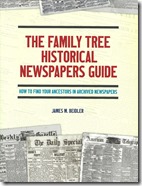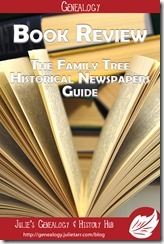 Title: The Family Tree Historical Newspapers Guide
Title: The Family Tree Historical Newspapers Guide
Author: James M. Beidler
Format: Paperback, Kindle
Published: 2018
My Rating: ![]()
![]()
![]()
![]()
The following review first appeared in the Federation of Genealogical Societies FORUM magazine (Fall 2018); reprinted with permission.
Newspapers are an important resource for genealogists. Yet, even with more and more newspapers finding their way online as digital images that can be searched, newspapers still seem to be an underutilized source. As you will learn in The Family Tree Historical Newspapers Guide, newspapers offer all sorts of gems for genealogical and historical research. We can use them to unlock the stories of our ancestors, as well as learn more about the time and place in which they lived. Beidler’s guide will introduce you to what you can find and how.
The book is divided into three parts. Part 1 mainly focuses on the “what” aspect of newspaper research. Before diving in, Beidler provides a brief history of newspapers, along with their evolution. Then he gets into the meat of newspapers, with chapters 2–4 describing what types of items you can expect to find in newspapers. Using various examples to illustrate potential uses for genealogy research, he thoroughly discusses the following: news articles, advertisements, editorials and letters to the editor, social columns, history and genealogy columns, birth and marriage “records” in various forms (such as announcements, license listings, anniversaries), divorces, obituaries and death notices, and other death “records” such as probate notices. Part 1 wraps up with a discussion of the various mediums you may come across (print, microfilm, digital), as well as other places you might find newspaper items, such as abstracts in society journals and manuscripts (both published and unpublished), and clippings in scrapbooks and vertical files.
In Part 2, Beidler discusses how to find newspapers, primarily online. Chapter 6 first discusses websites that have lists of where to find digitized newspapers, as well as sites that are search aggregators, such as Elephind. This chapter also highlights free collections, such as Chronicling America, Google News Archive, and Old Fulton New York Post Cards. Beidler also encourages readers to look at state/local archives and libraries who are digitizing and hosting their collections. Chapters 7 and 8 cover subscriptions websites Newspapers.com and GenealogyBank respectively. There is great information on how to use each of the sites’ features. The discussion of Newspapers.com briefly turned to its parent and sister companies Ancestry and Fold3 respectively, as each also have newspaper collections. In addition to the newspaper content available on GenealogyBank, Beidler also points out some of its other record collections. Chapter 9 covers subscription sites NewspaperArchives (in conjunction with Findmypast) and Accessible Archives, along with library subscriptions sites such as ProQuest. Part 2 concludes with a chapter on finding newspapers that have not been digitized, using a handful of online resources, and closes with a brief description of some of the major repositories that hold large newspaper collections.
Part 3 is all about digging deeper. In Chapter 11, you’ll learn about ethnic-related newspapers. Here, Beidler covers African American newspapers in depth, along with foreign-language newspapers. A quick tutorial on using Google Translate is also provided. Beidler briefly mentions other types of newspapers such as religious and labor union, but sadly does not go into much detail. International newspapers (those published outside the United States) is the topic of chapter 12. Discussed are some of the previously mentioned “big name” websites and sites that can help you find online collections. Chapter 13 provides tips for preserving both newspaper issues and clippings, and how to create source citations for your findings. The part concludes with a handful of case studies, illustrating how important newspapers are to genealogy research.
The books extras include three appendixes, one with a handy flowchart to get you started in newspaper research and one with a listing of resources, both general and state-specific. The third appendix presents a brilliant idea for charting the chronology of newspapers for a particular area to visually ascertain what was available when. An index and photo credits are also included.
If you want to break down a brick wall, learn more details about an ancestor’s life, or discover the social history of a time and place, but haven’t yet considered newspapers a part of your research toolbox, then you need to pick up a copy of this book.



Share your thoughts...